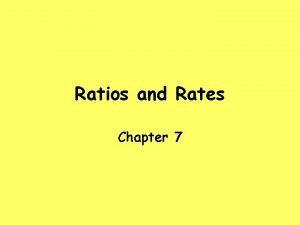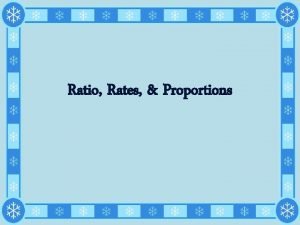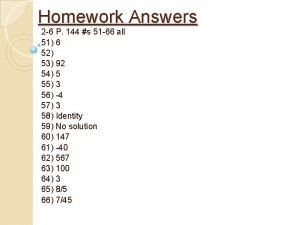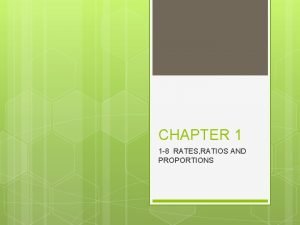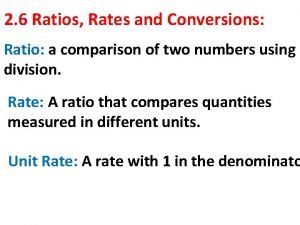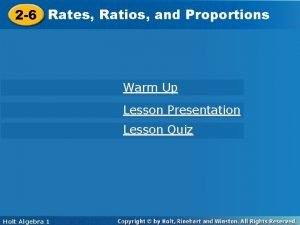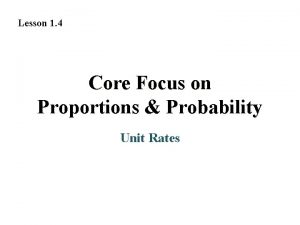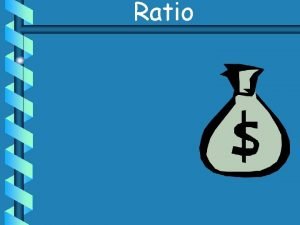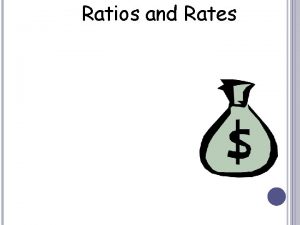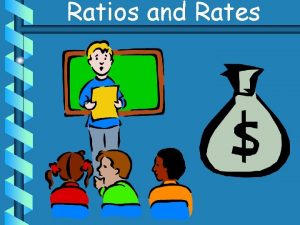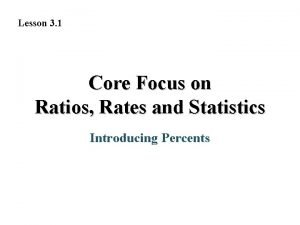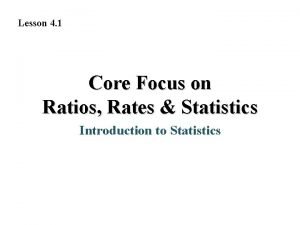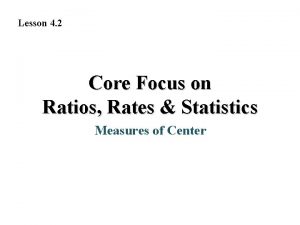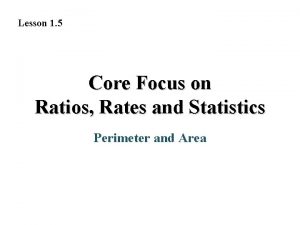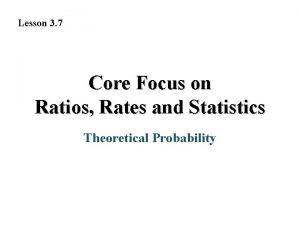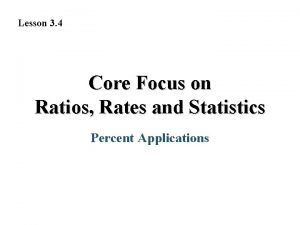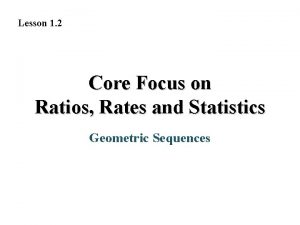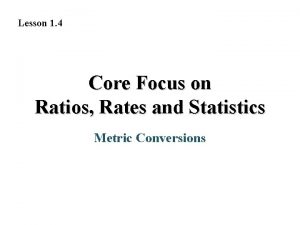Lesson 4 5 Core Focus on Ratios Rates


















- Slides: 18

Lesson 4. 5 Core Focus on Ratios, Rates & Statistics Box-and-Whisker Plots

Warm-Up Use the following data set: 23, 9, 24, 19, 15, 11, 5, 27, 23, 15, 31, 29, 22, 13, 16 1. Starting at 0 and using an interval width of 6, make a frequency table of the data. 2. Use your frequency table to make a histogram. 3. Which interval has the most values? 18 – 24 4. In which interval should the value 24 fall? 24 – 30 Interval Frequency 0– 6 1 6 – 12 2 12 – 18 4 18 – 24 5 24 – 30 3 30 – 36 1

Lesson 4. 5 Box-and-Whisker Plots Make, read and interpret box-and-whisker plots.

Vocabulary Five-Number Summary Describes the spread of numbers in a data set. The five-number summary divides a data set into four quartiles. Each section represents 25% of the data. 1 st Quartile (Q 1) The median of the lower half of a set of data. 3 rd Quartile (Q 3) The median of the upper half of a set of data.

Five-Number Summary Min ~ Q 1 ~ Median ~ Q 3 ~ Max Minimum: Smallest value 1 st Quartile: Median of the lower half Each section, or quartile, represents 25% of the data. Median: Middle value 3 rd Quartile: Median of the upper half Maximum: Largest value

Example 1 Find the five-number summary of the following data sets. a. 12, 14, 19, 20, 24, 28, 30 Find the median of the data set. 12, 14, 19, 20, | 24, 28, 30 22 Median Find the 1 st quartile. If there are two numbers in the middle, include one in each half of the data. 12, 14, | 19, 20, | 24, 28, 30 16. 5 Q 1

Example 1 Continued… Find the five-number summary of the following data sets. a. 12, 14, 19, 20, 24, 28, 30 Find the 3 rd quartile. 12, 14, 19, 20, | 24, | 28, 30 26 Q 3 Find the minimum and maximum. 12, 14, | 19, 20, | 24, | 28, 30 Min The five-number summary is 12 ~ 16. 5 ~ 22 ~ 26 ~ 30. Max

Example 1 Continued… Find the five-number summary of the following data sets. b. 10, 9, 9, 8, 6, 5, 9, 10, 8 Put the numbers in order. 5, 6, 8, 8, 9, 9, 9, 10 Find the median. 5, 6, 8, 8, 9, 9, 9, 10 Median Find the 1 st quartile. When there is an odd number of values in the set, do not include the median in either half. 5, 6, | 8, 8, 9, 9, 9, 10 7 Q 1

Example 1 Continued… Find the five-number summary of the following data sets. b. 10, 9, 9, 8, 6, 5, 9, 10, 8 Find the 3 rd quartile. 5, 6, | 8, 8, 9, 9, 9, | 10, 10 9. 5 Q 3 Find the minimum and maximum. 5, 6, | 8, 8, 9, 9, 9, | 10, 10 Min The five-number summary is 5 ~ 7 ~ 9. 5 ~ 10. Max

Vocabulary Interquartile Range (or IQR) The range of the middle half of the data. The IQR is another statistic which gives a measure of spread. Box-and-Whisker Plot A diagram used to display the five-number summary of a data set. A box-and-whisker plot shows when groups of numbers are clustered together or spaced apart in a set of data. Each section of the display represents 25% of the data.

Interquartile Range The interquartile range (IQR) is the difference between the third quartile and the first quartile in a set of data. IQR = Q 3 – Q 1

Example 2 Sonny plays basketball. The points he scored in his past eleven games are listed below. 6, 10, 11, 12, 14, 15, 15, 20, 23 a. Find the five-number summary. The middle number of the data set (the median) is 14. The median of the lower half of the data (Q 1) is 11. The median of the upper half (Q 3) is 15. The minimum is 6 and the maximum is 23. 6, 10, 11, 12, 14, 15, 15, 20, 23 Min Q 1 Median Q 3 Max The five-number summary is 6 ~ 11 ~ 14 ~ 15 ~ 23.

Example 2 Continued… Sonny plays basketball. The points he scored in his past eleven games are listed below. 6, 10, 11, 12, 14, 15, 15, 20, 23 b. Find the range and interquartile range of Sonny’s points scored. Find the range of the data. Find the interquartile range. Range = Maximum – Minimum = 23 – 6 = 17 IQR = Q 3 – Q 1 = 15 – 11 =4

Example 3 A grocery store manager collected data about the amount of money spent by the first eleven customers on a given day. Amount Spent: $1, $4, $5, $9, $10, $16, $20, $25, $48, $68 a. Construct a box-and-whisker plot to display the amounts spent by the customers. Find the five-number summary of the data. 1, 4, 5, 9, 10, 16, 20, 25, 48, 68 1 ~ 5 ~ 10 ~ 25 ~ 68

Example 3 Continued… Draw a number line. Create equal intervals on your number line that include the minimum (1) and maximum (68) data values. For this data set, a number line spanning from 0 to 70 with intervals of 5 works well. Create a box just above the number line that goes from the Q 1 value (5) to the Q 3 value (25). Draw a vertical line through the box where the median value (10) lies. Add “whiskers” to the ends of the box that extend out to the minimum and maximum values.

Example 3 Continued… A grocery store manager collected data about the amount of money spent by the first eleven customers on a given day. Amount Spent: $1, $4, $5, $9, $10, $16, $20, $25, $48, $68 b. Complete the following statement: “Fifty percent of the customers spent between $5 and $_____. ” The sections of the box and the whiskers each represent 25% “quartiles”. “Fifty percent of the customers spent between $5 and $25. ”

Communication Prompt Which type of graph do you prefer to make: a histogram, a dot plot or a box-and-whisker plot? Which type of graph do you think gives the most useful information about the spread of the data? Explain your answers.

Exit Problems 1. Create a box-and-whisker plot for the following data set. 62, 73, 78, 84, 86, 91, 95, 98 2. Use the box-and-whisker plot to answer the following questions. a) What percent of values are greater than 17? 50% 13 b) About 25% of the values are less than ____. 25 of the values are greater than 19. c) About ___%
 What is a unit ratio
What is a unit ratio Ratios and proportions guided notes
Ratios and proportions guided notes Ratios rates and unit rates
Ratios rates and unit rates Ratios rates and unit rates
Ratios rates and unit rates Ratio and rates
Ratio and rates Ratios, rates, and proportions
Ratios, rates, and proportions 4-1 lesson quiz
4-1 lesson quiz 2-6 practice ratios rates and conversions
2-6 practice ratios rates and conversions Rates ratios and proportions
Rates ratios and proportions 2-6 practice ratios rates and conversions
2-6 practice ratios rates and conversions 2-6 ratios and proportions
2-6 ratios and proportions 1-8 rates ratios and proportions
1-8 rates ratios and proportions For adult
For adult Porters generic strategy
Porters generic strategy Timex cost leadership strategy
Timex cost leadership strategy Actor focus vs object focus
Actor focus vs object focus Core focus on linear equations answer key
Core focus on linear equations answer key Core focus on proportions and probability answer key
Core focus on proportions and probability answer key Core focus on linear equations
Core focus on linear equations




